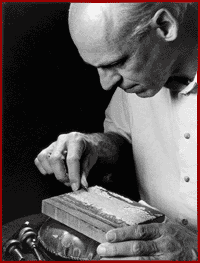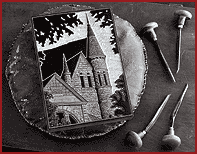New Hampshire Woodcut Artist
Works Against the Grain
 |
 |
|
Top:
Randy engraves a scene of Exeter, New
Hampshire.
Below: The Peters Hall wood engraving
just prior to completion. The boxwood
rests on a leather sandbag for easy
maneuverability; the gravers beside
it are made of tempered steel and ground
to a mirror finish on a Belgian honing
stone.
|
During
a brief, yet enchanting, stay in Boston following
his graduation in 1970,
Randy Miller discovered
the art of wood engraving. Inspired by the illustrations
found in old books, he questioned why the aged
art form wasn't more prominent today. He studied
books on the topic at the public library, and,
with some tools given to him by a woodworker,
made his first engraving on a small block of
maple. His 30-year-career as a wood engraver
and artist had begun.
With
burins and gravers in tow, Randy moved to Alstead,
New Hampshire, where he continued to develop
his expertise. One of the small number of artists
who continue to engrave wood blocks by hand
and use their own machinery to pull prints,
Randy was commissioned to illustrate a book
of short stories about land surveying in New
England. He then spent a year engraving 26 images
for a children's book, My Village, Sturbridge
(Farrar, Straus, & Giroux, New York), cited
by The New York Times in 1977 as one of the
ten best-illustrated children's books of the
year.
Focusing
on rural American landscapes, old buildings,
and scenes from the British Isles, Randy has
more than 200 engravings to his credit. From
these, he creates prints and note cards, magazine
and book illustrations, logo and letterhead
designs, and, commissioned works. The September
1999 issue of Colonial Homes magazine featured
Randy's prints in its "Master Craftsmen" section.
William
Peck '72, class president and member of the
planning committee for Oberlin's 2001 reunion,
happened upon Randy's web site recently and
recognized him as the co-captain of the College's
championship basketball team of 1970. Intrigued
by the artwork, Bill commissioned the artist
to illustrate the cover of the 1970-72 cluster
alumni reunion directory and gave him carte
blanche for subject matter.
 Randy
chose a view of Peters Hall because he finds
the building architecturally distinctive and
sentimentally poignant. The 5x7-inch engraving
took him about 65 days to complete--two days
for each square inch of engraved surface. Understandably,
he describes the creative process as "intense
and sometimes grueling."
Randy
chose a view of Peters Hall because he finds
the building architecturally distinctive and
sentimentally poignant. The 5x7-inch engraving
took him about 65 days to complete--two days
for each square inch of engraved surface. Understandably,
he describes the creative process as "intense
and sometimes grueling."
"I
was trying to juxtapose the intricate detail
in the stonework and ornaments of Peters with
a powerful sense of depth in the round tower,
which is achieved in the engraving by emphasizing
the shadows," he says.
Two
years ago, The Old Farmer's Almanac sought out
Randy for a new engraving to appear on the title
page of its millennium collector's edition,
only the fourth time the title-page illustration
has been changed since the Almanac's founding
in 1792. Randy's 18-year-old daughter modeled
for his rendering of the profile of Ceres, the
goddess of agriculture. The Almanac print was
the first of his works to use color, which was
added to the black and white print.
"Sometimes
I yearn to work with color," he muses, "but
the pleasure of engraving a clean, highly polished
block of hard wood is a compelling and absorbing
experience."
--by
David Shernoff '02

